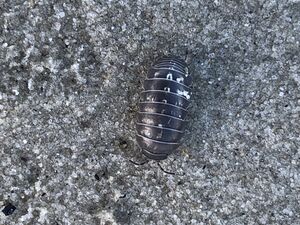Armadillidium vulgare
Pill bug - Armadillidium vulgare
Habitat This species is specifically a terrestrial crustacean. Their main habitat is under mulch, fallen leaves, logs, and rocks where it is dark, damp, and humid. The reason for living in a moist environment is due to the fact that they lack a waterproof cuticle wax, so they must hide in locations which prevent them from desiccation stress. Their preferred soil habitat is composed of organic matter because this is what they feed from.
Range A. vulgare is native to the Mediterranean originally, but they have now been introduced nearly worldwide. The pill bug can be found on almost every continent with the majority of populations being in temperate climates. One of the largest populations is throughout every state in the United States, but they can also be found in Madagascar, Australia, South Africa, India, Japan, France, Canada, central Bohemia, Romania, and the Czech Republic.
Description Pill bugs are small oval shaped crustaceans, also known as isopods, that are approximately 3/4-inches long. They have seven pairs of walking legs and two antennae. Their bodies are made of a hard outer cuticle that is usually dark brown or black and is segmented into plates. Their plates allow them to curl up in a ball as a defense mechanism when they feel threatened. The main part of the body has seven larger segments with also five smaller segments behind them. A. vulgare also has a set of appendages called uropods, near the posterior end of their bodies.
Ecological Notes Armadillidium vulgare has a life cycle that involves an egg stage, a juvenile stage called "manca", and a reproductive adult stage. There is no nauplius stage, unlike what most crustaceans posses. Embryos instead hatch as immaturely developed adults. The breeding interval is once annually in the northern hemisphere and twice in the southern hemisphere. The breeding season usually spans from late spring to early summer. The hatching season ends in early fall to late winter. This species on average produces about 100 eggs, but sometimes can be up to 300 eggs. Females and males reach sexual maturity when they are one year of age. Males offer no parental care of the eggs, while the mother broods the eggs up until their juvenile stage, where the offspring will then leave the nest. Typically, A. vulgare has a lifespan of about a year and a half up to a few years. During their life, most of their time is spent sheltering themselves from desiccation stresses. A majority of their time is also spent searching and scavenging for detritus from which they break down and use as their main food source. Herbivory and carnivory have also been observed in this species. While exposed, these ispods have a variety of defense mechanisms against predation such as use of their encrusted armor, repugnatorial glands which release unpleasant odors, uropods to sense danger, and their coloration which they use as camouflage.
Personal Information I encountered this species off the Atlantic shoreline in Cape Hatteras, North Carolina in April of 2018 during a beach-combing activity. This isopod was crawling through the sand near the water's edge when I passed it. When I observed it, the pill bug curled up in a ball to defend itself after I got within close proximity to it. In the area I encountered three pill bugs of this same species all near the water and crawling towards the grasses off the shore.
Journal Articles For more information on Armadillidium vulgare:
Brody, M.S., Lawlor, L.R. 1982. Adaptive variation in offspring size in terrestrial isopod, Armadillidium vulgare. Oecologia 61, 55-59.
This paper looks at the variation in the birth size of offspring of the terrestrial isopod A. vulgare through observations in lab and field populations. They noticed that females may be making larger sized offspring to increase survival during more severe conditions of summer dessication and during breeding periods.
Miller, R.H., Cameron, G.N. 1983. Intraspecific variation of life history parameters in terrestrial isopod, Armadillidium vulgare. Oecologia 57, 216-226.
This journal explores individual populations of this isopod in Texas coastal prairie habitats, a Chinese forest, oak forest, and a grassland area. By comparing time tables, these researchers compared populations to determine variation in their life history distributions.
References
http://entnemdept.ufl.edu/creatures/MISC/Armadillidium_vulgare.htm
http://animals.mom.me/background-information-pill-bugs-4459.html
http://animaldiversity.org/accounts/Armadillidium_vulgare/
Contributed by Jordin Vidmar - 2018
